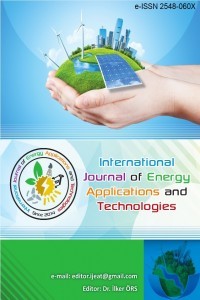A Comparison of Sequential Quadratic Programming, Genetic Algorithm, Simulated Annealing, Particle Swarm Optimization and Hybrid Algorithm for the Design and Optimization of Golinski’s Speed Reducer
A Comparison of Sequential Quadratic Programming, Genetic Algorithm, Simulated Annealing, Particle Swarm Optimization and Hybrid Algorithm for the Design and Optimization of Golinski’s Speed Reducer
optimization, golinski’s speed reducer design parameters, limitation,
___
- [1] Ray, Tapabrata. "Golinski's speed reducer problem revisited." AIAA journal 41.3 (2003): 556-558.
- [2] Datseris, P. "Weight minimization of a speed reducer by heuristic and decomposition techniques." Mechanism and Machine Theory 17.4 (1982): 255-262.
- [3] Deb, Kalyanmoy, et al. "A fast and elitist multiobjective genetic algorithm: NSGA-II." IEEE transactions on evolutionary computation 6.2 (2002): 182-197.
- [4] Kennedy, James. "Particle swarm optimization." Encyclopedia of machine learning. Springer US, 2011. 760-766.
- [5] Dorigo, Marco, and Luca Maria Gambardella. "Ant colony system: a cooperative learning approach to the traveling salesman problem." IEEE Transactions on evolutionary computation 1.1 (1997): 53-66.
- [6] Hassan, Rania, et al. "A comparison of particle swarm optimization and the genetic algorithm." 46th AIAA/ASME/ASCE/AHS/ASC Structures, Structural Dynamics and Materials Conference. 2005.
- [7] Yang, Chunming, and Dan Simon. "A new particle swarm optimization technique." Systems Engineering, 2005. ICSEng 2005. 18th International Conference on. IEEE, 2005.
- [8] Eberhart, Russell, and James Kennedy. "A new optimizer using particle swarm theory." Micro Machine and Human Science, 1995. MHS'95., Proceedings of the Sixth International Symposium on. IEEE, 1995.
- [9] Eberhart, Russell C., and Yuhui Shi. "Evolving artificial neural networks." Proceedings of the International Conference on Neural Networks and Brain. Vol. 1. No. 998. PRC, 1998..
- [10] Eberhart, Russell C., and Yuhui Shi. "Comparison between genetic algorithms and particle swarm optimization." International Conference on Evolutionary Programming. Springer Berlin Heidelberg, 1998.
- Yayın Aralığı: Yılda 2 Sayı
- Başlangıç: 2014
- Yayıncı: İlker ÖRS
Measurement of Energy Consumption of WSN for Indoor Environment
Development of a household anaerobic digester for rural areas in Sudan
Hazir FAROUK, Mutaz ELOBAİD, Omer ABDELAZİM, Mohammed SALAH, Khalid BAKHEET, Andrew Lang
Cenker Aktemur, Islam Gusseinov
THE EFFECTS OF INCENTIVES ON RENEWABLE ENERGY RESOURCES FOR HOME USERS
FATİH BULUT, Murat LÜY, Ertugrul ÇAM
